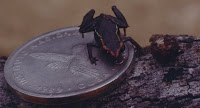
Bee Hummingbird (Calypte helenae)
This bird is the world's smallest bird species.
This bird grows to a maximum length of 2.25 in.
This species is an endemic bird species of Cuba.
The Cuban Hummingbird has been labeled as threatened since 2000 due to loss of habitat.
This species is usually found in forests, gardens, and valleys.

This species of iguana is listed as vulnerable in Cuba.
It can be commonly found on the U.S. Naval base of Guantanamo Bay, Cuba.

Cuban Kite (Chondrohierax wilsoni)
The Cuban Kite is a critically endangered species due to habitat loss.
It was once thought extinct, but 3 birds were recently found in eastern Cuba.
The Cuban Kite's habitat is heavily forested land.
This species is thought to feed mostly on snails.

Cuban Parakeet (Aratinga euops)
This species is endemic to Cuba.
This bird has been labeled as vulnerable since 2000 due to habitat loss and trapping.

Cuban Trogon (Priotelus temnurus)
This species of bird is known as Cuba's national bird becuase its coloration is the same as the Cuban Flag.
Cuban Hutia (Capromys pilorides)
The Cuban Hutia is the largest endemic land mammal of Cuba.
It can grow to be about 60 cm in length.
This rodent lives in the forests and rocky areas of Cuba.
This animal is an omnivore and is known to eat fruits, leaves, small reptiles, and small mammals.
Many other Hutia species are critically endangered on the island of Cuba.
This bird is the world's smallest bird species.
This bird grows to a maximum length of 2.25 in.
This species is an endemic bird species of Cuba.
The Cuban Hummingbird has been labeled as threatened since 2000 due to loss of habitat.
This species is usually found in forests, gardens, and valleys.

Cuban Ground Iguana (Cyclura nubila)
This species of iguana is listed as vulnerable in Cuba.
It can be commonly found on the U.S. Naval base of Guantanamo Bay, Cuba.
Cuban Solenodon (Solenodon cunbanus)
The Solenodon is endangered and was once thought to be extinct.
This species is an insectivore and feeds mostly on insects and spiders.
The Cuban Solenodon is found mostly in forests and thick shrub habitats.
This is a nocturnal species, spending the day hiding under rocks or in trees
The Solenodon is endangered and was once thought to be extinct.
This species is an insectivore and feeds mostly on insects and spiders.
The Cuban Solenodon is found mostly in forests and thick shrub habitats.
This is a nocturnal species, spending the day hiding under rocks or in trees
Cuban Crocodile (Crocodilius rhombifer)
This crocodile can grow to be up to 4.9m in length
 This species is endangered due to the loss of its habitat. It currently has the smallest wild habitat area of any crocodile and will only swim in fresh water habitats.
This species is endangered due to the loss of its habitat. It currently has the smallest wild habitat area of any crocodile and will only swim in fresh water habitats.
Cuban crocodiles feed on fish, turtles, and small mammals.
The crocodile was hunted for its skin and meat in the past. However, it has been protected as an endangered species since 1996.
This crocodile can grow to be up to 4.9m in length
 This species is endangered due to the loss of its habitat. It currently has the smallest wild habitat area of any crocodile and will only swim in fresh water habitats.
This species is endangered due to the loss of its habitat. It currently has the smallest wild habitat area of any crocodile and will only swim in fresh water habitats.Cuban crocodiles feed on fish, turtles, and small mammals.
The crocodile was hunted for its skin and meat in the past. However, it has been protected as an endangered species since 1996.
Monte Iberia Dwarf Eleuth (Eleutherodactylus iberia)
This endangered species is endemic to Cuba.
It is primarily nocturnal, finding cover during the day and moving about at night.
This species is extremely small (as seen in the picture) and is the smallest of its genus
This endangered species is endemic to Cuba.
It is primarily nocturnal, finding cover during the day and moving about at night.
This species is extremely small (as seen in the picture) and is the smallest of its genus

Cuban Kite (Chondrohierax wilsoni)
The Cuban Kite is a critically endangered species due to habitat loss.
It was once thought extinct, but 3 birds were recently found in eastern Cuba.
The Cuban Kite's habitat is heavily forested land.
This species is thought to feed mostly on snails.

Cuban Parakeet (Aratinga euops)
This species is endemic to Cuba.
This bird has been labeled as vulnerable since 2000 due to habitat loss and trapping.

Cuban Trogon (Priotelus temnurus)
This species of bird is known as Cuba's national bird becuase its coloration is the same as the Cuban Flag.
Cuban Hutia (Capromys pilorides)
The Cuban Hutia is the largest endemic land mammal of Cuba.
It can grow to be about 60 cm in length.
This rodent lives in the forests and rocky areas of Cuba.
This animal is an omnivore and is known to eat fruits, leaves, small reptiles, and small mammals.
Many other Hutia species are critically endangered on the island of Cuba.
.






















No comments:
Post a Comment